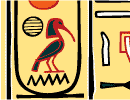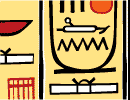Keys to this period
1) Romans rule for nearly seven centuries
2) Peaceful period
Summary
For nearly seven centuries after the death of Cleopatra, the Romans controlled Egypt (except for a short time in the 3rd century AD, when it came under the power of Queen Zenobia of Palmyra). They treated Egypt as a valuable source of wealth and profit and were dependent on its supply of grain to feed their multitudes. Roman Egypt was governed by a prefect, whose duties as commander of the army and official judge were similar to those of the pharaohs of the past. The office, therefore, was one with which the native population was familiar. Because of the immense power of the prefects, however, their functions were eventually divided under Emperor Justinian, who in the 6th century AD put the army under a separate commander, directly responsible to him. Egypt in the Roman period was relatively peaceful; its southern boundary at Asw‚n was only rarely attacked by the Ethiopians. Egypt's population had become Hellenized under the Ptolemies, and it included large minorities of Greeks and Jews, as well as other peoples from Asia Minor. The mixture of the cultures did not lead to a homogeneous society, and civil strife was frequent. In 212, however, Emperor Caracalla granted the entire population citizenship in the Roman Empire.
Alexandria, the port city on the Mediterranean founded by Alexander the Great, remained the capital as it had been under the Ptolemies. One of the great metropolises of the Roman Empire, it was the center of a thriving commerce between India and Arabia and the Mediterranean countries. It was the home of the great Alexandrian library and museum and had a population of some 300,000 (excluding slaves).
Egypt became an economic mainstay of the Roman Empire not only because of its annual harvest of grain but also for its glass, metal, and other manufactured products. In addition, the trade brought in spices, perfumes, precious stones, and rare metals from the Red Sea ports. Once part of the empire, Egypt was subject to a variety of taxes as well. In order to control the people and placate the powerful priesthood, the Roman emperors protected the ancient religion, completed or embellished temples begun under the Ptolemies, and had their own names inscribed on them as pharaohs; the cartouches of several can be found at Isna, Kawn Umbu, Dandara, and Philae. The Egyptian cults of Isis and Serapis spread throughout the ancient world. Egypt was also an important center of early Christendom and the first one of Christian monasticism. Its Coptic or Monophysite church separated from mainstream Christianity in the 5th century.
During the 7th century the power of the Eastern Roman (Byzantine) Empire was challenged by the Sassanids of Persia, who invaded Egypt in 616. They were expelled again in 628, but soon after, in 642, the country fell to the Arabs, who brought with them a new religion, Islam, and began the first chapters of modern Egyptian history as its Ancient History ended with the Roman rule.
|
|
|





